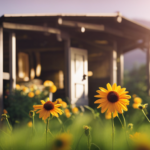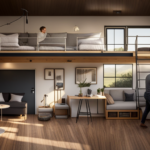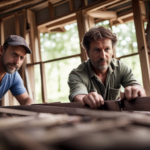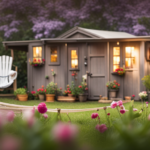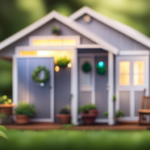Beginners Guides
How To Turn A Shed Into A Tiny House
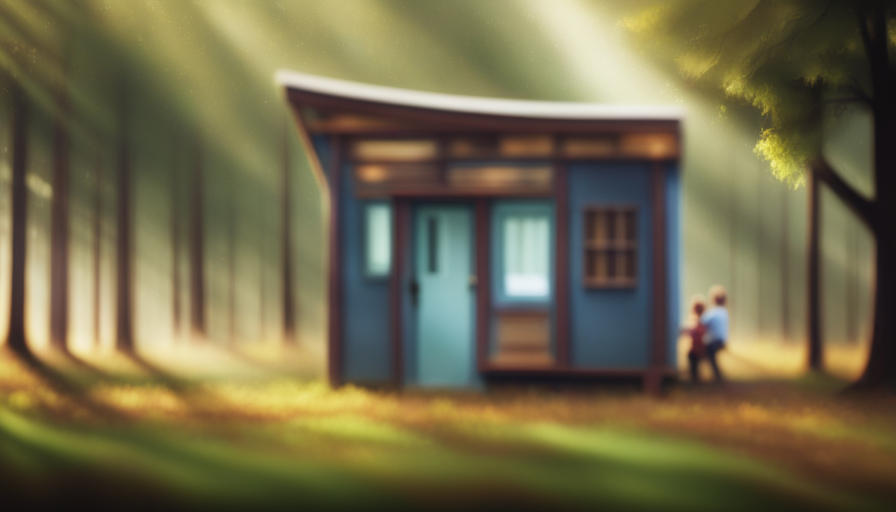
Imagine a snug, delightful area tucked away at the end of your backyard, offering a refuge from the day-to-day rush. This space is entirely your own, equipped with the comforts and amenities of a home, yet in a more compact form. This captures the charm of transforming a shed into a tiny house.
In this article, I will guide you through the process of transforming your humble shed into a functional and stylish tiny house. We will start by assessing the condition and size of your shed, ensuring it is suitable for your needs. Then, we will discuss the purpose of your tiny house and create a design plan that maximizes space and functionality.
Next, we will tackle the important task of insulating and weatherproofing the shed, making it comfortable and energy-efficient. We will also explore how to install utilities and plumbing, so you can enjoy all the modern conveniences in your tiny haven.
Once the practical aspects are taken care of, we will delve into the realm of exterior finishes, ensuring your tiny house blends seamlessly with its surroundings. Safety and compliance are paramount, and I will provide tips on how to ensure your tiny house meets all necessary regulations.
Finally, we will explore the fun part – personalizing and decorating your tiny house to reflect your unique style and personality. From clever storage solutions to creative space-saving ideas, I will share practical tips to make the most of your small living space.
So, if you’re ready to embark on this exciting journey of transforming a shed into a tiny house, let’s get started!
Key Takeaways
- Assess the condition and size of the shed before starting the transformation
- Consider the purpose of the tiny house and design it accordingly
- Insulate and weatherproof the shed for comfort and energy efficiency
- Personalize and decorate the tiny house to create a space that reflects values and supports well-being
Assess the Shed’s Condition and Size
Now, let’s take a moment to assess the shed’s condition and size to determine if it has the potential to be transformed into a charming and functional tiny house.
Assessing the budget is a crucial step in this process. Consider the costs of materials, labor, permits, and any additional expenses that may arise during the renovation. It’s important to have a clear understanding of how much you’re willing to invest in this project before proceeding further.
Next, evaluate the shed’s structural integrity. Check for any signs of damage, such as rotting wood, cracks in the foundation, or water leaks. These issues can significantly impact the feasibility of converting the shed into a tiny house. It’s essential to address any structural problems before beginning the renovation to ensure the safety and longevity of your tiny house.
Additionally, consider the size of the shed. Is it large enough to accommodate your needs? Measure the dimensions and compare them to your desired floor plan. Keep in mind that you’ll need space for a kitchen, bathroom, living area, and sleeping quarters. If the shed is too small, you may need to reconsider your plans or consider expanding the structure.
Now that you’ve assessed the shed’s condition, budget, and size, it’s time to decide on the purpose of your tiny house. Will it be used as a vacation retreat, a guesthouse, or a permanent residence? This decision will guide your design choices and determine the level of comfort and functionality you aim to achieve.
Decide on the Purpose of Your Tiny House
When deciding on the purpose of my tiny house, I first consider if it’ll be a guest house, a home office, or a personal retreat. This helps me determine the layout and functionality of the space.
Next, I think about the specific features and amenities I want to include, such as a kitchenette, bathroom, or outdoor seating area. Taking the time to carefully consider these factors ensures that my tiny house will meet my needs and provide a comfortable living space.
Consider if it will be a guest house, home office, or personal retreat
First, think about what you want your shed-turned-tiny-house to be: a cozy guest house, a productive home office, or a tranquil personal retreat. If you envision it as a guest house, consider incorporating guest house design elements to create a warm and inviting space. Look for shed renovation ideas that maximize comfort and privacy for your guests, such as adding a separate entrance and bathroom facilities.
On the other hand, if you plan to use it as a home office, focus on creating a productive and inspiring environment. Consider factors like natural light, storage solutions, and a comfortable workspace.
Lastly, if you want your shed to be a personal retreat, think about creating a peaceful and calming space. Incorporate elements like comfortable seating, a reading nook, and natural materials.
Once you have decided on the purpose, you can move on to determining the specific features and amenities you want to include, seamlessly transitioning into the next section.
Determine the specific features and amenities you want to include
Consider your shed as a blank canvas, and envision the specific features and amenities you desire to transform it into your dream space. Here are some design considerations and cost estimation to help you plan your transformation:
-
Insulation: Determine if you want to insulate your shed for year-round use and factor in the cost of materials and labor.
-
Electricity: Decide if you need electrical wiring for lights, outlets, and appliances. Consider the cost of hiring an electrician for installation.
-
Plumbing: If you want a bathroom or kitchenette, think about the plumbing requirements and the expense of hiring a plumber.
-
Heating and Cooling: Consider the climate in your area and decide if you need heating and cooling systems, such as a space heater or air conditioner.
By carefully considering these design elements and estimating their costs, you can create a realistic plan for your shed-to-tiny-house transformation.
Now, let’s move on to creating a design plan for your dream space.
Create a Design Plan
To create a cozy and functional tiny house, start by envisioning a design plan for your shed transformation. Design considerations are crucial at this stage, as they’ll determine the layout and overall aesthetic of your tiny house.
Think about how you want to utilize the space and what features are important to you. Consider factors such as the number of rooms, the size of the kitchen and bathroom, and the overall flow of the house. Additionally, think about any special amenities you want to include, such as a lofted sleeping area or a built-in storage solution.
Once you have a clear vision of your design plan, it’s important to check with your local authorities about building permits. Depending on where you live, you may need to obtain permits for the conversion of your shed into a dwelling. Make sure to research the specific regulations and requirements in your area to ensure compliance with the law.
With your design plan in hand and any necessary permits obtained, you can now move on to the next step of the transformation process: insulating and weatherproofing the shed. This will ensure that your tiny house is comfortable and protected from the elements, allowing you to enjoy your new space in any season.
Insulate and Weatherproof the Shed
After envisioning your design plan, the next step is to ensure that your shed is properly insulated and weatherproofed to protect your cozy space from the elements.
Insulating your shed will help maintain a comfortable temperature inside and reduce energy costs. There are various insulation materials available, such as fiberglass batts, foam boards, or spray foam insulation. Fiberglass batts are affordable and easy to install, while foam boards offer excellent insulation and moisture resistance. Spray foam insulation provides an airtight seal but may require professional installation.
To weatherproof your shed, start by sealing any gaps or cracks with caulk or weatherstripping. This will prevent drafts and moisture from entering your tiny house. Additionally, consider adding insulation to the floor and ceiling to further enhance the energy efficiency of your space.
Incorporating weatherproofing techniques like installing a vapor barrier and using waterproof paint on the exterior will protect your shed from moisture damage. A vapor barrier prevents condensation from forming inside the walls, while waterproof paint helps seal and protect the exterior from rain and humidity.
With your shed properly insulated and weatherproofed, you can now transition to installing utilities and plumbing to make your tiny house fully functional.
Install Utilities and Plumbing
When it comes to turning a shed into a tiny house, one of the key considerations is whether or not to have electricity, water, and plumbing. Personally, I believe having these utilities is essential for a comfortable and functional living space.
However, it’s important to determine your specific needs and budget before making a decision. If you’re not comfortable with or knowledgeable about installing utilities, it’s best to hire a professional to ensure they’re safely and properly installed.
On the other hand, if you’re willing to learn and have the necessary skills, installing these utilities yourself can be a cost-effective option. Just make sure to educate yourself on the necessary codes and regulations to avoid any potential issues down the line.
Determine if you want electricity, water, and/or plumbing in your tiny house
Consider whether you’d like to have electricity, water, and/or plumbing in your new tiny house, as these additions can greatly enhance your living experience. Having access to these utilities provides convenience and comfort, but it also comes with its own set of considerations.
Here are a few things to think about:
-
Pros and cons of off-grid living: Going off-grid means you can be self-sufficient and reduce your reliance on traditional energy sources. However, it requires careful planning and may limit some modern conveniences.
-
Minimizing your ecological footprint: By incorporating renewable energy sources like solar panels and rainwater collection systems, you can reduce your impact on the environment and live more sustainably.
-
Balancing your needs and budget: Installing utilities can be costly, so it’s important to determine what you truly need and what you can afford.
To safely install these utilities, you have two options: hire a professional or learn how to do it yourself. Both have their advantages, and it’s essential to weigh the pros and cons before making a decision.
Hire a professional or learn how to safely install these utilities yourself
Opting to enlist the expertise of a professional or acquiring the necessary knowledge to safely install electricity, water, and plumbing in your tiny house can ensure a seamless integration into your new abode.
Learning the necessary skills to do it yourself (DIY) or hiring a professional both have their pros and cons. If you choose to go the DIY route, it’s important to prioritize safety precautions and follow a step-by-step guide. Common challenges may include navigating building codes and permits, as well as finding inspiration for the design. Additionally, cost comparison is crucial to determine if hiring a professional fits within your budget. Tips and tricks from experienced individuals can also help simplify the process.
Transitioning into the next section about building and installing interior features, it’s essential to consider the layout and functionality of your tiny house.
Build and Install Interior Features
When it comes to turning a shed into a tiny house, one of the key steps is to construct walls, ceilings, and floors. This involves framing out the space, insulating properly, and installing drywall or paneling for a finished look.
Another important aspect is to install storage solutions, furniture, and appliances to make the space functional and livable. This includes building shelves, cabinets, and closets for storage, as well as installing a kitchenette, bathroom fixtures, and any necessary appliances for day-to-day living.
Construct walls, ceilings, and floors
To transform your shed into a cozy tiny house, start by building sturdy walls, installing a beautiful ceiling, and laying down a solid floor. Here are three key things to consider when constructing these essential elements:
-
Choosing materials for construction: Opt for high-quality materials that are durable and suitable for the climate in your area. Consider using materials like drywall or plywood for the walls, tongue and groove panels for the ceiling, and laminate or vinyl flooring for the floor. These materials will provide insulation, strength, and a pleasing aesthetic.
-
Maximizing space utilization: When constructing the walls, consider adding built-in shelves or cabinets to optimize storage space. Install a loft or mezzanine area to create additional usable space. Utilize ceiling height by installing overhead storage solutions or hanging racks. These clever design choices will help you make the most of your tiny house.
Once the walls, ceilings, and floors are complete, it’s time to move on to the next step of your shed transformation. Install storage solutions, furniture, and appliances to create a comfortable living space.
Install storage solutions, furniture, and appliances
After completing the walls, ceilings, and floors, it’s time to bring your cozy space to life by installing storage solutions, furniture, and appliances, creating a homey atmosphere where every item has its place.
In a tiny house, maximizing space is essential, so it’s crucial to choose storage solutions designed for small spaces. Consider using vertical shelving units, wall-mounted organizers, and under-bed storage containers to make the most of every inch. Utilize multipurpose furniture, such as a sofa bed or a dining table with built-in storage compartments. Compact appliances like a mini-fridge, a two-in-one washer and dryer, and a combination oven and microwave can save valuable space.
Organize your belongings efficiently, ensuring that everything is easily accessible and clutter-free. With smart storage solutions in place, you can maximize your tiny house’s functionality and create a comfortable living space.
Now, let’s move on to add exterior finishes to complete the transformation.
Add Exterior Finishes
With a fresh coat of paint, your shed can be transformed into a cozy and inviting tiny house. When it comes to exterior finishes, you have two main options: paint or siding.
Painting the exterior of your shed/tiny house is a cost-effective way to add color and protect the structure from the elements. Choose a high-quality exterior paint that’s durable and weather-resistant. Consider using lighter colors to make the space feel larger, or go for a bold color to make a statement.
Alternatively, you can opt for siding, which provides a more finished and polished look. There are various types of siding materials available, such as vinyl, wood, or fiber cement. Select one that suits your style and budget.
Once you have finished the exterior, don’t forget about the surrounding landscape. Incorporate landscaping ideas that complement your tiny house and create a welcoming outdoor space. Plant flowers, shrubs, and trees to add beauty and privacy. Create a pathway leading to the entrance and add outdoor furniture for relaxation. Enhance the overall aesthetic by adding lighting fixtures, such as solar-powered lights or decorative lanterns.
Now that the exterior of your tiny house is complete, it’s time to ensure safety and compliance with local regulations. This includes checking for proper insulation, installing smoke detectors, and following electrical codes. By addressing these important considerations, you can transform your shed into a safe and comfortable tiny house that meets all necessary requirements.
Ensure Safety and Compliance
Ensuring safety and compliance is crucial to transforming your shed into a cozy and inviting space that meets all necessary regulations, like a well-fitted puzzle piece in a larger picture.
Before you begin any modifications or renovations, it’s important to check with your local building department to understand the specific requirements and obtain any necessary permits. Ensuring compliance not only keeps you and your loved ones safe but also ensures that your tiny house is legally recognized.
When it comes to safety, there are a few key areas to focus on. First, make sure your electrical system is up to code. Hire a licensed electrician to inspect and upgrade the wiring if needed. Additionally, consider installing smoke and carbon monoxide detectors to keep you alerted to any potential hazards.
Next, pay attention to the structural integrity of your shed. Check for any signs of water damage, rot, or pest infestation. Reinforce the foundation, walls, and roof as necessary to ensure stability and longevity.
Consider the overall layout and design of your tiny house. Ensure that there are proper exits in case of an emergency, such as windows or doors that can be easily accessed. Additionally, make sure the space is well-insulated to provide comfort and energy efficiency.
By ensuring safety and compliance, you can confidently move forward with personalizing and decorating your tiny house, creating a space that reflects your unique style and personality.
Personalize and Decorate Your Tiny House
Now that you’ve ensured the safety and compliance of your tiny house, it’s time to move on to the fun part – personalizing and decorating your new space! This is where you can truly make your tiny house feel like home.
When it comes to decorating a tiny house, it’s important to keep in mind that less is more. You want to maximize the space you have while still creating a cozy and inviting atmosphere. One of the best decorating tips for small spaces is to choose furniture and decor that serves multiple functions. For example, a storage ottoman can double as a coffee table and provide additional storage space.
Another great way to personalize your tiny house is to incorporate your own style and interests. Whether you’re into minimalist, bohemian, or farmhouse decor, there are plenty of ways to make your tiny house reflect your unique personality. Consider adding personal touches like artwork, photographs, or even a small indoor plant to bring life and character to your space.
Remember, the key to decorating a tiny house is to be intentional and purposeful with your choices. Every item should serve a purpose and contribute to the overall functionality and aesthetics of your home. With these personalization ideas in mind, you’ll be well on your way to creating a tiny house that is both practical and beautiful.
As we continue on this journey of transforming a shed into a tiny house, the next section will focus on embracing small living and making the most of the limited space available.
Embrace Small Living
Embrace the cozy lifestyle of living in a small space and discover the freedom that comes with simplifying your surroundings. Embracing small living isn’t just about turning a shed into a tiny house; it’s about adopting a minimalist lifestyle and reaping the benefits of downsizing.
One of the main advantages of embracing small living is the ability to simplify your life. When you have a smaller space, you’re forced to prioritize and only keep the essentials. This not only helps you declutter physically but also mentally. Living in a tiny house encourages you to let go of unnecessary possessions and focus on what truly matters.
Another benefit of small living is the financial freedom it brings. With a smaller space, your expenses decrease significantly. Utility bills are lower, and you have less space to fill with unnecessary purchases. This allows you to save money and live a more sustainable lifestyle.
Living in a small space also promotes a sense of contentment and mindfulness. You learn to appreciate the simple things in life and find joy in the little moments. By embracing small living, you create a space that reflects your values and supports your well-being.
Embracing small living goes beyond the physical act of turning a shed into a tiny house. It involves adopting a minimalist lifestyle and experiencing the benefits of downsizing. So, let go of the excess and embrace the cozy freedom of living in a small space.
Frequently Asked Questions
How much does it typically cost to turn a shed into a tiny house?
When considering the cost of turning a shed into a tiny house, there are a few things to keep in mind. First, it depends on whether you choose to do it yourself or hire professionals. DIY can save money, but it requires time, skills, and knowledge. Hiring professionals can be more expensive, but they bring expertise and efficiency.
Additionally, cost considerations include materials, permits, insulation, electrical wiring, plumbing, and interior finishes.
What are some common challenges or obstacles that people face when converting a shed into a tiny house?
Common shed conversion mistakes include not properly insulating the shed, neglecting to plan for plumbing and electrical needs, and underestimating the amount of storage space required.
To maximize natural light in a shed turned tiny house, consider adding windows or skylights strategically to allow for ample sunlight. Additionally, using light-colored paint for the walls and ceilings can help reflect light and create a brighter space. Utilizing mirrors can also help to bounce light around the interior.
Are there any specific building codes or permits required for converting a shed into a tiny house?
When it comes to converting a shed into a tiny house, it’s important to be aware of the building codes and permits that may be required. These regulations ensure that the structure meets safety standards and is suitable for habitation. Building codes dictate things like electrical wiring, plumbing, and insulation, while permits are necessary to ensure compliance with zoning and land use regulations.
It’s crucial to research and obtain the necessary permits before starting your shed-to-tiny-house conversion project.
What are some clever storage solutions or space-saving techniques for maximizing the limited square footage in a shed-turned-tiny house?
When it comes to maximizing the limited square footage in a shed-turned-tiny house, clever storage solutions and space-saving techniques are key.
Utilizing vertical space with shelves and hooks can help keep belongings organized and off the floor.
Installing built-in storage units, such as under-bed drawers or wall-mounted cabinets, can also help make the most of every inch.
Additionally, using multi-functional furniture, like fold-down tables or sofa beds, can help save space and serve multiple purposes in a small area.
Can a shed be converted into a tiny house if it is located in an area with extreme weather conditions, such as very hot summers or cold winters?
Converting a shed into a tiny house in an area with extreme weather conditions requires careful planning and insulation.
Insulating the shed properly is crucial to maintain a comfortable temperature inside. Adding insulation to the walls, roof, and floor will help regulate the heat during hot summers and retain warmth during cold winters.
Consider using insulation materials like foam board, spray foam, or fiberglass. Don’t forget to seal any gaps or cracks to prevent drafts and ensure energy efficiency.
Conclusion
In conclusion, transforming a shed into a tiny house is like turning a caterpillar into a beautiful butterfly.
With careful planning and hard work, you can create a cozy and functional living space that suits your needs.
From assessing the shed’s condition to adding personal touches, every step is crucial in this metamorphosis.
Embrace the simplicity and charm of small living, and watch your shed transform into a captivating sanctuary.
So spread your wings and embark on this exciting journey of turning a humble shed into a remarkable tiny house.
Hi, I’m Emma. I’m the Editor in Chief of Tiny House 43, a blog all about tiny houses. While tree houses are often associated with childhood, they can be the perfect adult retreat. They offer a cozy space to relax and unwind, surrounded by nature. And since they’re typically built on stilts or raised platforms, they offer stunning views that traditional homes simply can’t match. If you’re looking for a unique and romantic getaway, a tree house tiny house might just be the perfect option.
Beginners Guides
How Did the City of Fresno to Tiny House
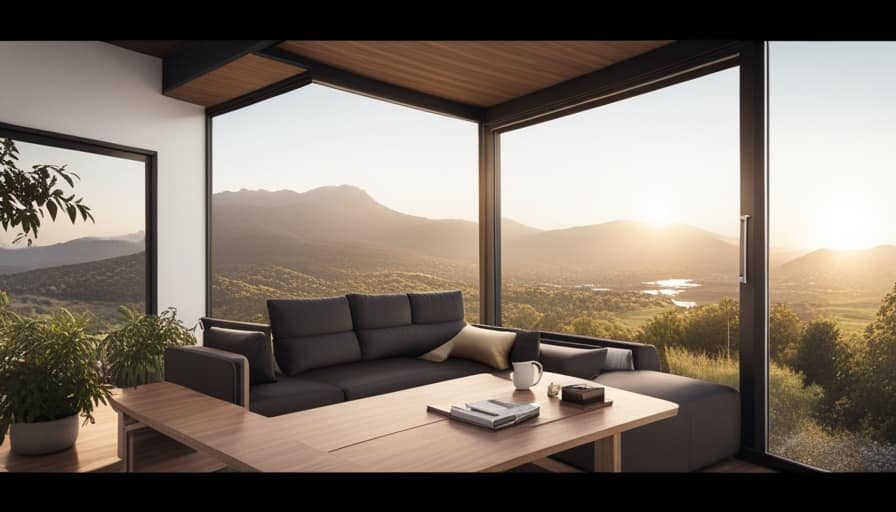
As someone living in Fresno, I have always believed in the saying ‘home is where the heart is.’ Thanks to the city’s forward-thinking housing policies, even the smallest of homes can now have a place to call their own.
In this article, we’ll explore how Fresno has embraced the tiny house movement, collaborating with advocates and implementing innovative zoning regulations. Join me as we delve into the challenges faced and the remarkable progress made towards building a thriving tiny house community in Fresno.
Key Takeaways
- Fresno has implemented housing policies and initiatives aimed at increasing access to affordable housing, including energy-efficient homes and tiny house construction.
- Collaboration with tiny house advocates is crucial for effective housing solutions, as they bring valuable insights and innovative ideas to the table.
- Zoning regulations and permitting processes in Fresno are designed to engage the community and ensure that their needs and preferences are considered.
- Fresno has created innovative tiny house communities that focus on sustainability and affordability, incorporating features such as solar panels and rainwater harvesting systems.
The Shift in Housing Policies
I’m excited to talk about the changes happening in housing policies.
One of the most pressing issues in our society today is housing affordability. Many individuals and families struggle to find affordable housing options, causing financial strain and instability.
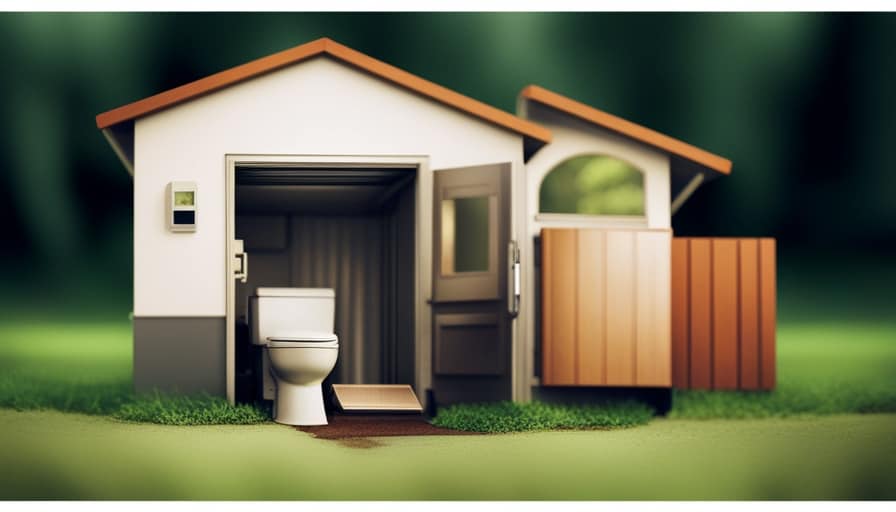
As a result, there’s been a shift in housing policies towards promoting sustainable living and increasing access to affordable housing. Governments and organizations are recognizing the importance of creating housing opportunities that are both environmentally friendly and economically viable.
This involves initiatives such as promoting energy-efficient homes, supporting the construction of tiny houses, and implementing rent control measures.
Collaborating With Tiny House Advocates
Collaborating with tiny house advocates has been crucial in implementing effective housing solutions in the city of Fresno. Through collaboration strategies and community engagement, we’ve been able to work hand in hand with advocates to address the unique challenges and opportunities that tiny houses present.
These collaborations have allowed us to tap into the knowledge and expertise of tiny house advocates, who bring valuable insights and innovative ideas to the table. We’ve engaged in open and transparent dialogues, fostering a sense of trust and understanding between all parties involved.
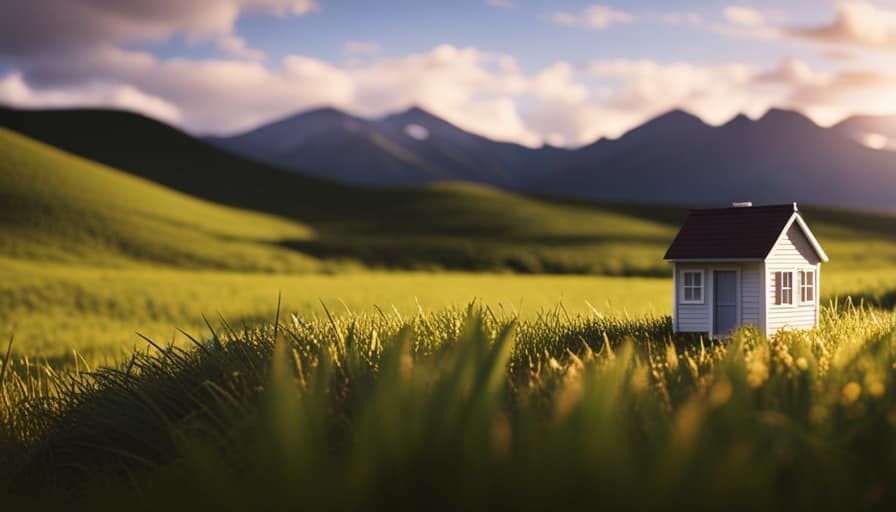
Zoning Regulations and Permitting Processes
Navigating the complexities of zoning regulations and permitting processes can be challenging, but it’s essential for ensuring the successful implementation of tiny house communities in the city of Fresno.
To streamline processes and make it easier for individuals and organizations to develop tiny house communities, the city of Fresno has taken steps to engage with the community and actively involve them in the decision-making process.
This includes hosting public meetings, soliciting feedback, and conducting thorough assessments of potential sites for tiny house communities. By involving the community in these processes, the city of Fresno can address any concerns or issues that may arise, while also ensuring that the needs and preferences of the community are taken into consideration.
This collaborative approach not only helps to build trust and support, but also allows for a more efficient and effective implementation of tiny house communities in the city.
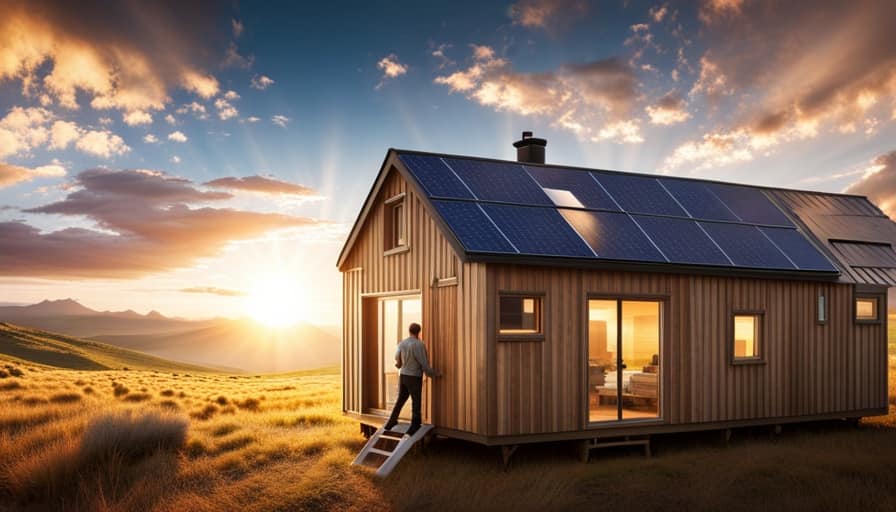
Innovative Tiny House Communities in Fresno
One innovative approach to creating tiny house communities in Fresno is through the use of sustainable materials and renewable energy sources. These communities are designed with a focus on sustainability, incorporating features such as solar panels, rainwater harvesting systems, and energy-efficient appliances. By utilizing these sustainable practices, residents can reduce their carbon footprint and live in homes that are environmentally friendly.
Additionally, these communities aim to provide affordable living options for individuals who may not be able to afford traditional housing. Through the use of smaller, more efficient spaces, the cost of construction and maintenance is reduced, making it more accessible for those on a limited budget.
These innovative tiny house communities in Fresno are paving the way for sustainable housing and promoting affordable living for all.
Transitioning into the next section, let’s explore the challenges faced in building a tiny house movement.
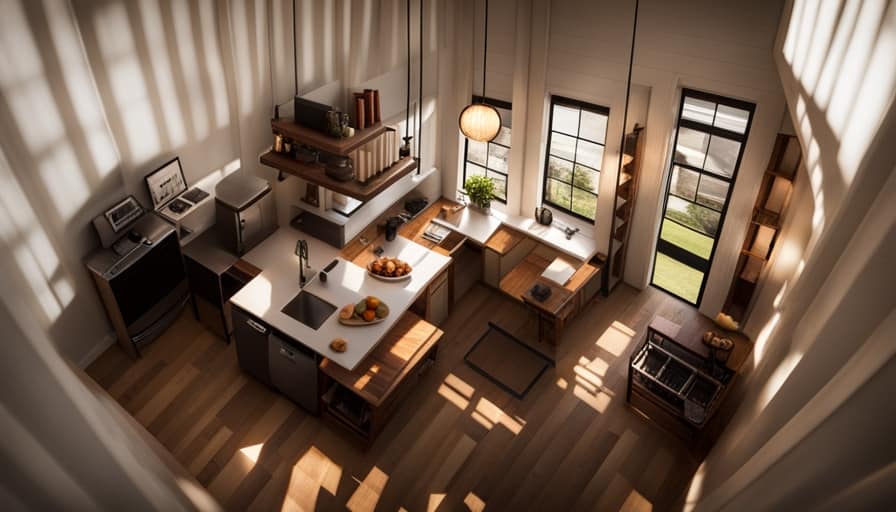
Overcoming Challenges and Building a Tiny House Movement
Confronting obstacles and working together, we can create a thriving tiny house movement in Fresno.
To overcome challenges and build a sustainable and affordable housing solution, we must first address zoning regulations. Currently, many cities have restrictions that make it difficult to build tiny houses on a permanent foundation. By advocating for changes in zoning laws, we can create more opportunities for tiny house communities.
Additionally, we need to address financing options for individuals interested in building tiny houses. Traditional lending institutions may not provide loans for these unconventional homes, so alternative financing options must be explored. Collaborating with local government, community organizations, and financial institutions can help us develop innovative solutions to overcome these challenges.
Frequently Asked Questions
How Long Does It Typically Take to Build a Tiny House?
Typically, it takes around 2-4 months to build a tiny house. The building timeline can vary based on factors like design complexity, availability of materials, and contractor availability. Cost considerations include materials, labor, and permits.
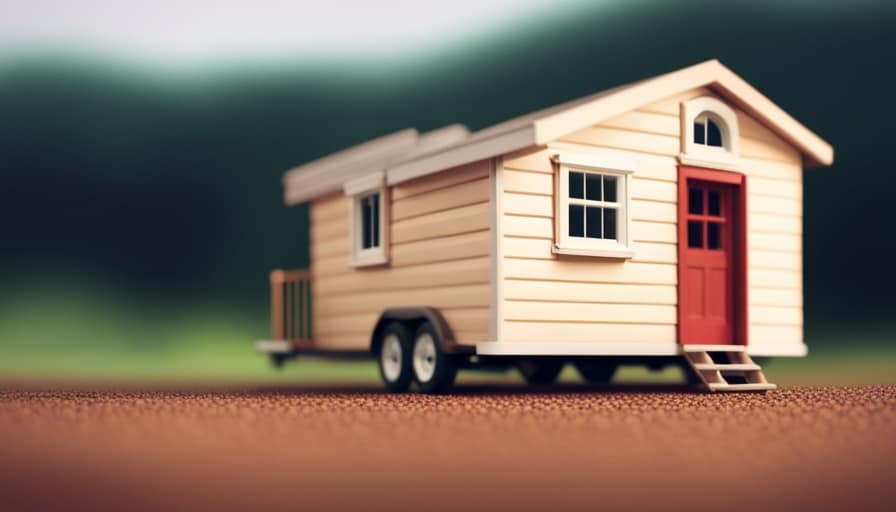
Are There Any Specific Requirements for the Size or Design of a Tiny House in Fresno?
In Fresno, specific requirements exist for the size and design of tiny houses. The city has set guidelines to ensure safety and conformity. Meeting these requirements is crucial to obtaining necessary permits and building a legally compliant tiny house.
Can I Legally Live in a Tiny House on Wheels in Fresno?
Yes, you can legally live in a tiny house on wheels in Fresno. While specific regulations may vary, other cities have implemented tiny house regulations with benefits such as affordability, sustainability, and minimal environmental impact.
How Can I Find Resources and Support for Building My Own Tiny House in Fresno?
Finding local workshops and connecting with tiny house builders in Fresno is crucial for building my own tiny house. Through thorough research and analytical thinking, I can discover resources and support to ensure a successful project.
Are There Any Financial Incentives or Grants Available for Individuals Interested in Building a Tiny House in Fresno?
There are financial assistance programs and grants available for individuals interested in building a tiny house in Fresno. It’s important to familiarize yourself with the building regulations and requirements to ensure compliance.
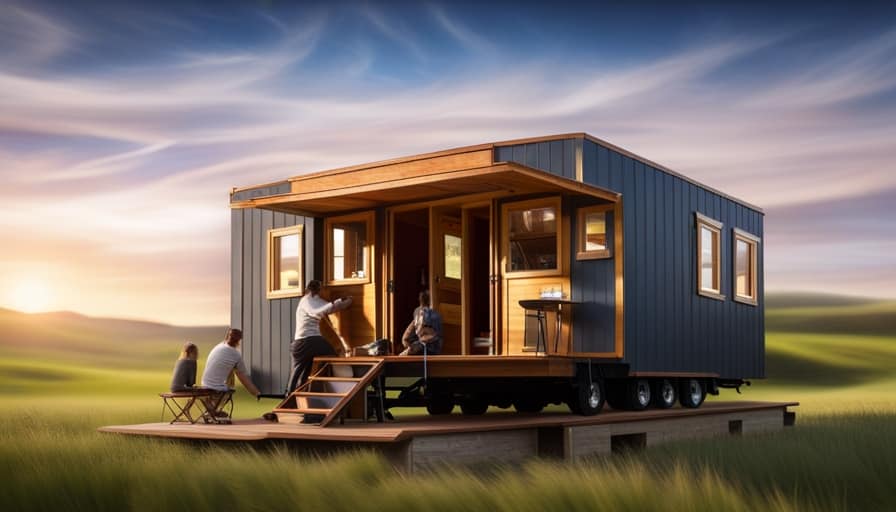
Conclusion
In conclusion, the city of Fresno has successfully embraced the tiny house movement through a shift in housing policies, collaboration with advocates, and innovative communities.
The zoning regulations and permitting processes have been streamlined to accommodate tiny house living. Despite challenges, the city has built a strong foundation for the tiny house movement to thrive.
As the saying goes, "The journey of a thousand miles begins with a single step," and Fresno has taken that step towards a more sustainable and affordable housing solution.
I’m Theodore, and I love tiny houses. In fact, I’m the author of Tiny House 43, a book about tiny houses that are also tree houses. I think they’re magical places where imaginations can run wild and adventures are just waiting to happen.
While tree houses are often associated with childhood, they can be the perfect adult retreat. They offer a cozy space to relax and unwind, surrounded by nature. And since they’re typically built on stilts or raised platforms, they offer stunning views that traditional homes simply can’t match.
If you’re looking for a unique and romantic getaway, a tree house tiny house might just be the perfect option.
Beginners Guides
How Do I Get Rid of Tiny Black Flies in My House
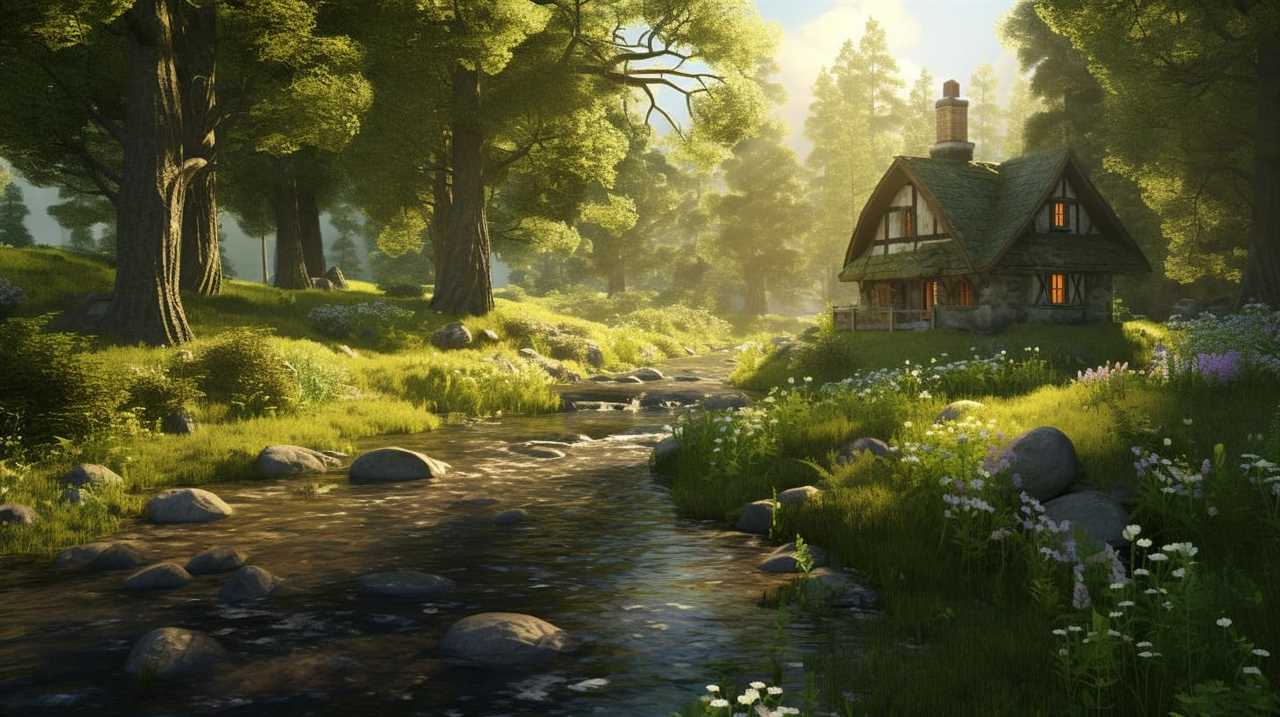
- Health risks associated with tiny black flies in the house
- Effective methods to prevent and control the presence of black flies in homes or gardens
I have tried every possible solution, but those annoying tiny black flies refuse to leave my house!
If you’re dealing with the same frustrating problem, don’t worry – I’ve got you covered.
In this article, I’ll share my expert knowledge on identifying these pesky bugs, understanding the causes of their infestations, and provide you with both natural and chemical remedies to banish them for good.
Say goodbye to those annoying flies and hello to a fly-free home!
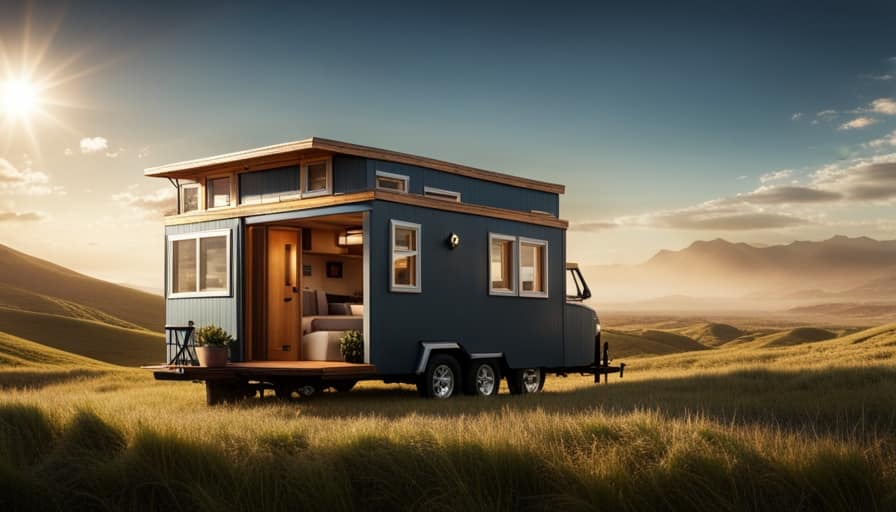
Key Takeaways
- Identify and eliminate breeding grounds by removing standing water and damp areas.
- Use natural remedies like homemade fly traps with apple cider vinegar and essential oils to repel flies.
- Consider using chemical treatments designed to kill black flies, following the instructions carefully.
- Take preventive measures to keep your house clean and free from food or organic debris to prevent future infestations.
Identifying the Tiny Black Flies
I can use a magnifying glass to examine the tiny black flies and determine their species. When it comes to differentiating between fruit flies and black flies, there are a few key characteristics to look out for.
Fruit flies are usually smaller in size, about 1/8 of an inch long, and have a tan or yellowish body with red eyes. On the other hand, black flies are slightly larger, measuring around 1/4 of an inch, and have a dark black or grayish body with dark wings.
Now, let’s move on to controlling and eliminating black flies in outdoor spaces. One effective method is to eliminate their breeding grounds by removing any standing water or damp areas where they can lay their eggs. Regularly emptying and cleaning birdbaths, flower pots, and gutters can help prevent black fly infestations.
Additionally, using insect repellents or installing fine mesh screens on doors and windows can provide some protection against these pesky pests.
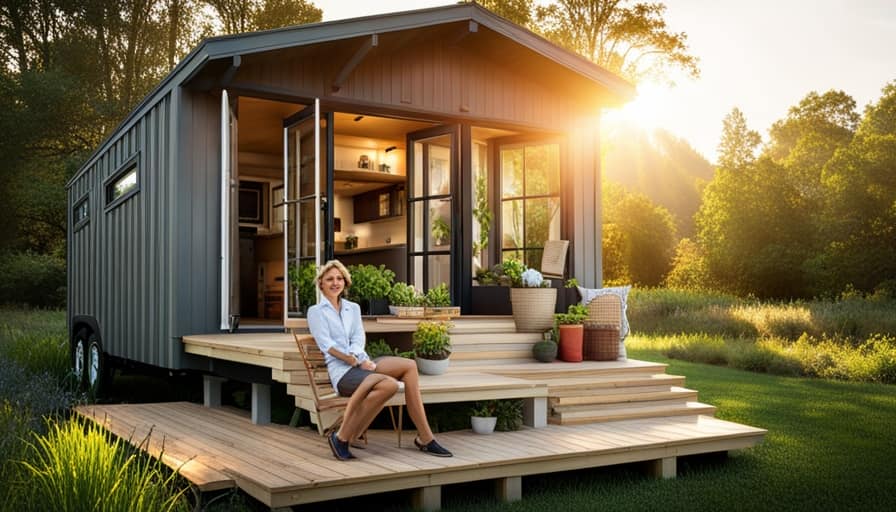
Understanding the Causes of Black Fly Infestations
To understand the causes of black fly infestations, we need to examine their preferred breeding sites and environmental conditions. These tiny pests thrive in moist and decaying organic matter, making the following places common breeding grounds for black flies:
-
Standing water: Black flies lay their eggs in standing water, such as ponds, lakes, and even puddles. It’s crucial to eliminate any stagnant water sources around your house to prevent infestations.
-
Overgrown vegetation: Black flies are attracted to dense vegetation, especially if it’s near water bodies. Trim shrubs, mow your lawn regularly, and remove any overgrown plants to discourage black flies from breeding.
-
Moist organic matter: Black flies lay their eggs in decomposing leaves, grass clippings, and other organic debris. Keep your yard clean and free of debris to reduce the likelihood of black fly infestations.
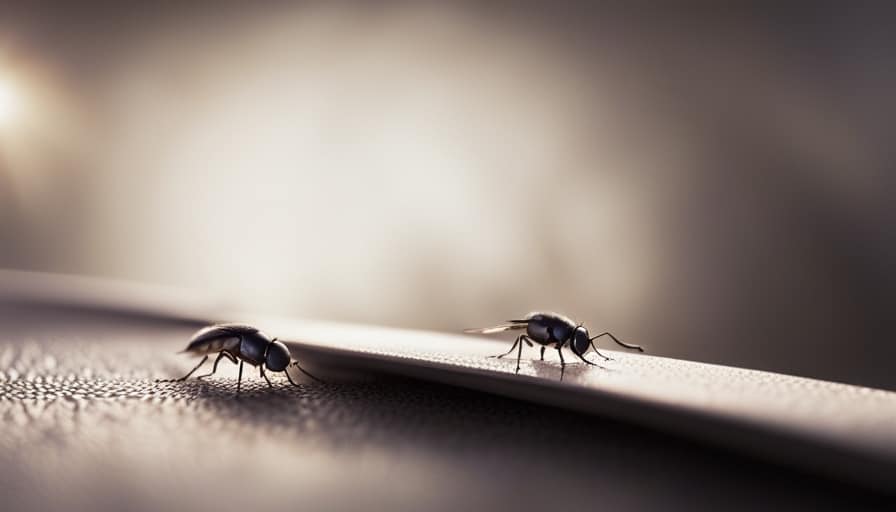
Understanding these common breeding grounds can help you identify and eliminate the causes of black fly infestations, keeping your home fly-free and comfortable.
Natural Remedies to Eliminate Tiny Black Flies
With a combination of proper sanitation and natural remedies, you can effectively eliminate tiny black flies from your house. One effective natural remedy is making homemade fly traps. These traps can be made using common household items such as apple cider vinegar, dish soap, and a plastic bottle. Simply cut the bottle in half, pour a mixture of apple cider vinegar and dish soap into the bottom half, and place the top half of the bottle inverted into the bottom half. The flies will be attracted to the scent of the vinegar, but the dish soap will prevent them from escaping. Another natural remedy is using essential oils for fly control. Oils such as lavender, peppermint, and eucalyptus have strong scents that repel flies. Simply mix a few drops of your chosen oil with water and spray it around areas where flies are present. By incorporating these natural remedies into your fly control routine, you can effectively get rid of tiny black flies in your house.
| Homemade Fly Traps | Essential Oils for Fly Control |
|---|---|
| – Apple cider vinegar and dish soap mixture in a plastic bottle | – Lavender, peppermint, and eucalyptus oils |
| – Flies are attracted to the vinegar scent but trapped by the soap | – Mix a few drops with water and spray in affected areas |
| – Simple and cost-effective solution | – Oils have strong scents that repel flies |
| – Dispose of trapped flies regularly | – Repeat application as needed |
Chemical Treatments for Getting Rid of Black Flies
By using chemical treatments, you can effectively eliminate black flies from your house. Here are three options to consider:
-
Chemical insecticides: These products are specifically designed to kill insects, including black flies. Look for insecticides that are labeled for use against flies and follow the instructions carefully. Apply the insecticide in areas where black flies are commonly found, such as around windows, doors, and other entry points.
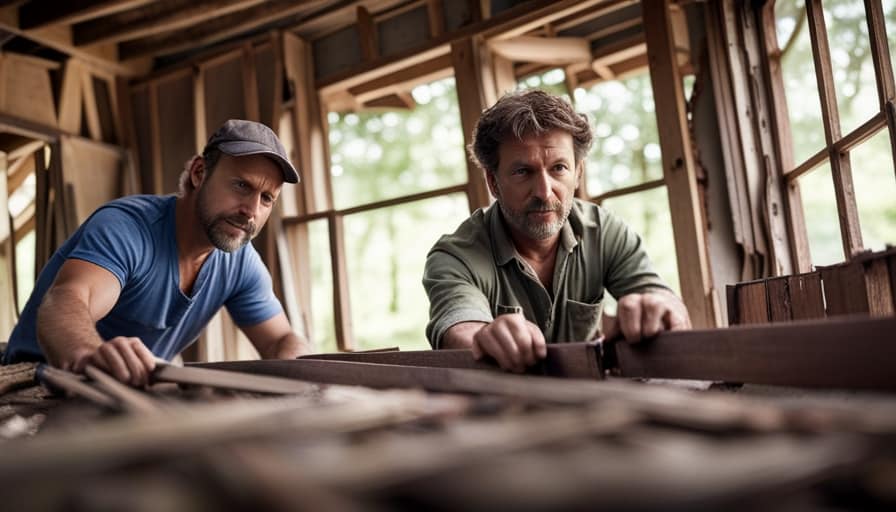
-
Fly traps: There are chemical-based fly traps available that attract and capture black flies. These traps use a combination of chemicals and pheromones to lure the flies in and prevent them from escaping. Place the traps in areas where black flies are present, such as near garbage cans or in the kitchen.
-
Professional exterminator: If you’re dealing with a severe infestation or if chemical treatments haven’t been effective, it may be best to call a professional exterminator. They have access to stronger chemicals and can provide a targeted approach to eliminate black flies from your house.
Remember to always read and follow the instructions on chemical insecticides and traps, and consider the help of a professional if needed.
Preventing Future Infestations of Tiny Black Flies
My best advice for preventing future infestations of tiny black flies in my house is to maintain proper sanitation and eliminate potential breeding grounds.
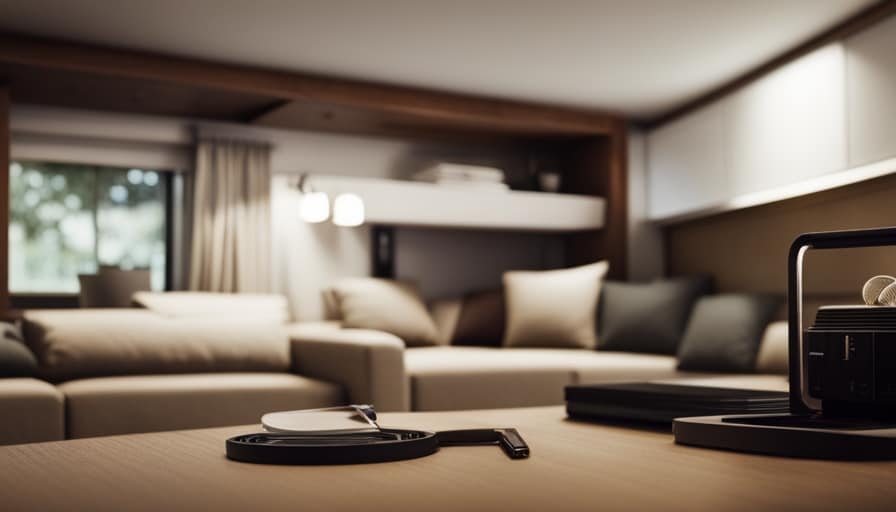
To maintain a fly-free environment, it’s important to keep your house clean and free from any food or organic debris. Make sure to regularly clean your kitchen, especially the countertops, sinks, and garbage disposal areas. Keep all food stored in airtight containers and promptly clean up any spills or crumbs.
Additionally, it’s crucial to identify and eliminate common breeding grounds for black flies in homes. These include standing water, damp areas, and overwatered plants. Regularly check for any leaks or moisture issues and fix them promptly.
Frequently Asked Questions
Can These Tiny Black Flies Harm Humans or Pets?
I’m not an expert, but I can share that tiny black flies in the house might be annoying, but they usually don’t harm humans or pets. It’s always a good idea to take preventive measures to control their presence.
Are There Any Specific Regions or Climates Where These Black Flies Are More Common?
In certain regions and climates, these pesky black flies tend to be more common. Understanding their preferences can help in devising effective strategies to keep them at bay.
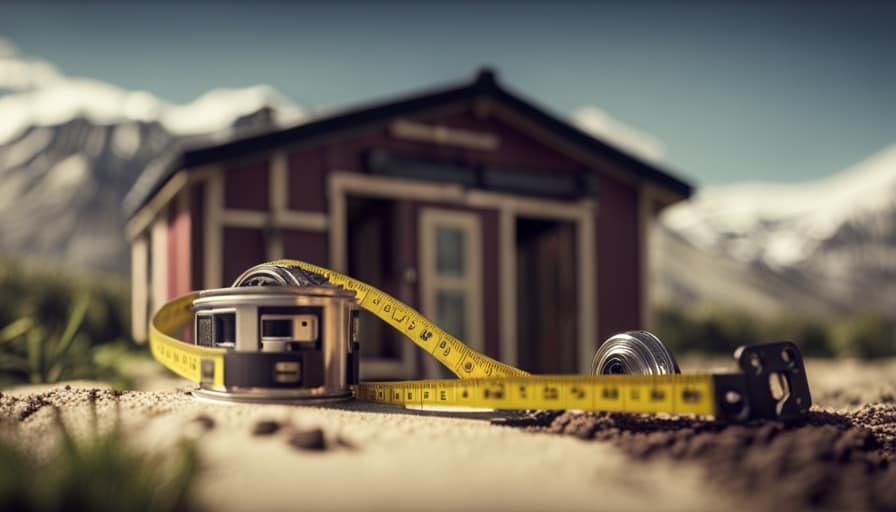
Can These Tiny Black Flies Cause Damage to Plants or Food?
Yes, these tiny black flies can cause damage to indoor plants as they lay their eggs in the soil. They can also contaminate stored food by landing on it and leaving behind bacteria.
How Long Does It Usually Take for Natural Remedies to Effectively Eliminate Black Flies?
On average, natural remedies can effectively eliminate black flies within a few days. However, the exact time may vary depending on the severity of the infestation and the specific remedies used.
Are There Any DIY Traps or Baits That Can Be Used to Catch and Eliminate These Tiny Black Flies?
There are several DIY fly traps and effective baits that can be used to catch and eliminate those pesky tiny black flies. Let me share some knowledge and details on how you can tackle this issue.
Conclusion
So there you have it, a plethora of methods to bid farewell to those pesky tiny black flies that have invaded your humble abode.
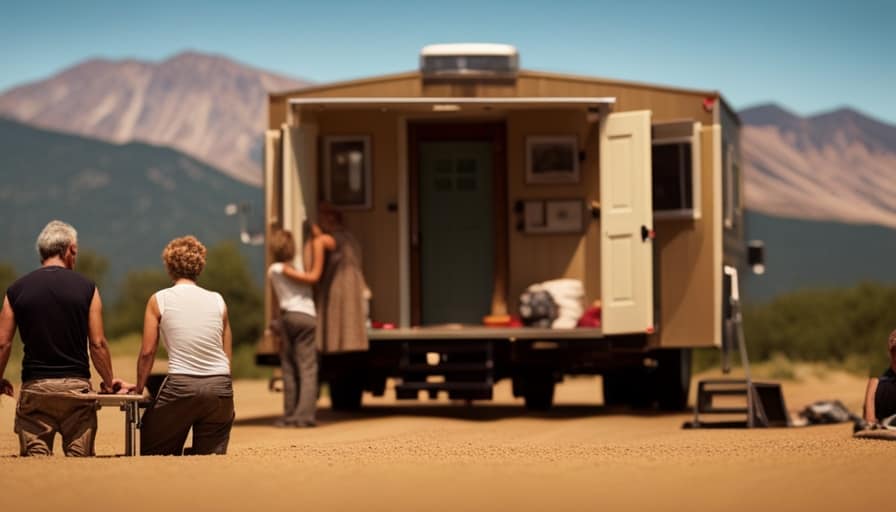
From natural remedies to chemical treatments, we’ve covered it all.
Now, armed with this knowledge, you can take control of your home and ensure these unwelcome guests never return.
Happy fly-free living!
I’m Theodore, and I love tiny houses. In fact, I’m the author of Tiny House 43, a book about tiny houses that are also tree houses. I think they’re magical places where imaginations can run wild and adventures are just waiting to happen.
While tree houses are often associated with childhood, they can be the perfect adult retreat. They offer a cozy space to relax and unwind, surrounded by nature. And since they’re typically built on stilts or raised platforms, they offer stunning views that traditional homes simply can’t match.
If you’re looking for a unique and romantic getaway, a tree house tiny house might just be the perfect option.
Beginners Guides
How Do I Get Rid of Tiny Bugs in My House

I have pests in my home that are causing me frustration! They are like small intruders that are appearing all over the place. However, do not worry, as I have conducted thorough research and found effective solutions to eliminate these bothersome pests.
In this article, I’ll guide you through identifying the types of bugs, understanding the causes of infestations, and providing natural and chemical remedies to eliminate them.
Say goodbye to those unwelcome guests and hello to a bug-free home!
Key Takeaways
- Identifying the specific pest by observing droppings or behavior is crucial in getting rid of tiny bugs in the house.
- Proper sanitation practices, such as keeping the kitchen and dining areas clean, are important in preventing bug infestations.
- Natural remedies like herbal insecticides and essential oils can be effective in deterring bugs without the use of harsh chemicals.
- Regular cleaning, sealing cracks, and maintaining a tidy home are essential in preventing future bug infestations.
Identifying the Types of Tiny Bugs in Your House
I can easily identify the types of tiny bugs in my house by observing their physical characteristics and behavior. One of the most common signs of an infestation is the presence of droppings or excrement. Different types of bugs leave different types of droppings, which can help determine the specific pest in your house.
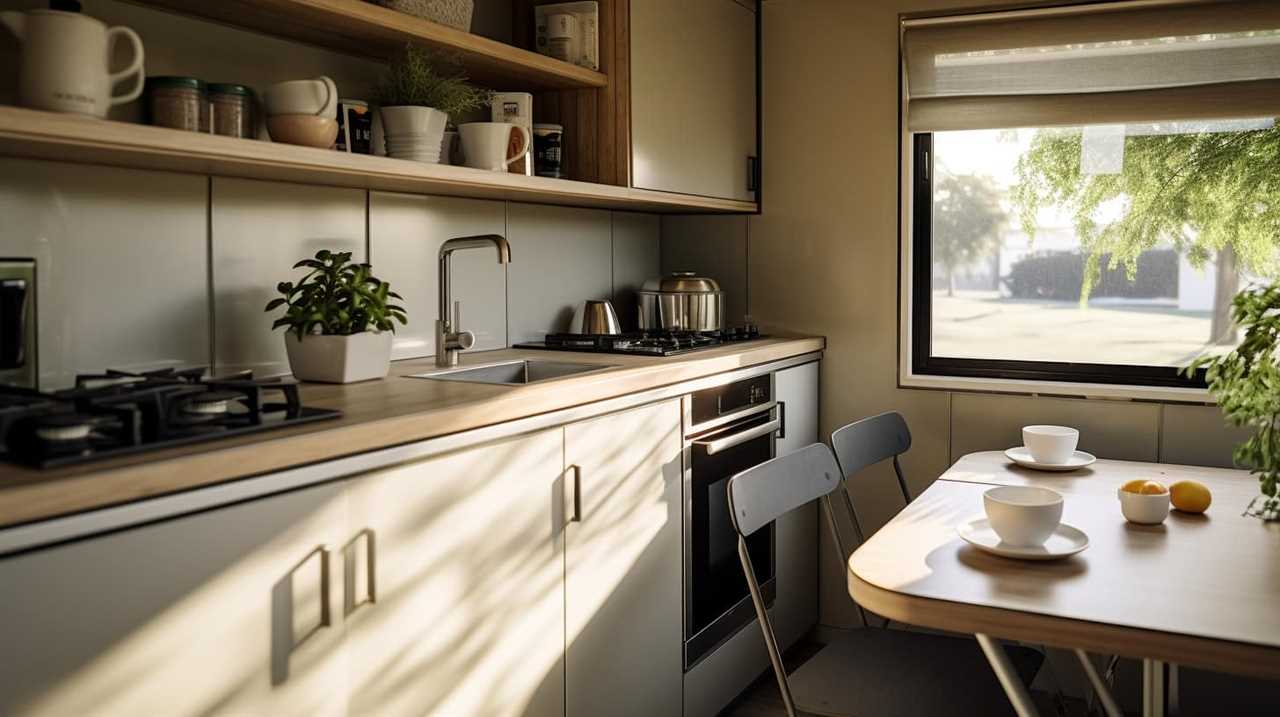
Additionally, observing the behavior of the bugs can provide valuable information. Some bugs are more active during the day, while others are nocturnal. Some bugs may prefer certain areas of the house, such as the kitchen or bathroom.
If you’re unsure about the type of bug in your house, it’s advisable to consult with professional exterminators who’ve the expertise to accurately identify and eliminate the pests.
Understanding the Common Causes of Bug Infestations
One of the most common causes of bug infestations is a lack of proper sanitation practices in the home. Understanding bug behavior and knowing their common household bug habitats can help prevent infestations.
Bugs are attracted to food sources, so it’s important to keep the kitchen and dining areas clean and free of crumbs and spills. Regularly emptying and cleaning garbage cans can also deter bugs from entering the home.

Additionally, bugs thrive in warm and moist environments, so it’s important to fix any leaks or damp areas in the house. Cluttered spaces provide hiding spots for bugs, so keeping the home organized and decluttered can help minimize their presence.
Natural Remedies to Get Rid of Tiny Bugs in Your House
To effectively eliminate tiny bugs in your house, try using natural remedies with ingredients such as vinegar and essential oils. Natural remedies are a great option for those who prefer non-toxic solutions and want to avoid harsh chemicals.
One effective natural remedy is using herbal insecticides. These insecticides are made from plant-based ingredients and can be sprayed in areas where bugs are commonly found, such as corners, cracks, and crevices.
Another natural remedy to consider is essential oils. Certain essential oils, such as peppermint, lavender, and tea tree oil, have insect-repellent properties. Simply mix a few drops of the essential oil with water and spray it around your house to deter bugs.
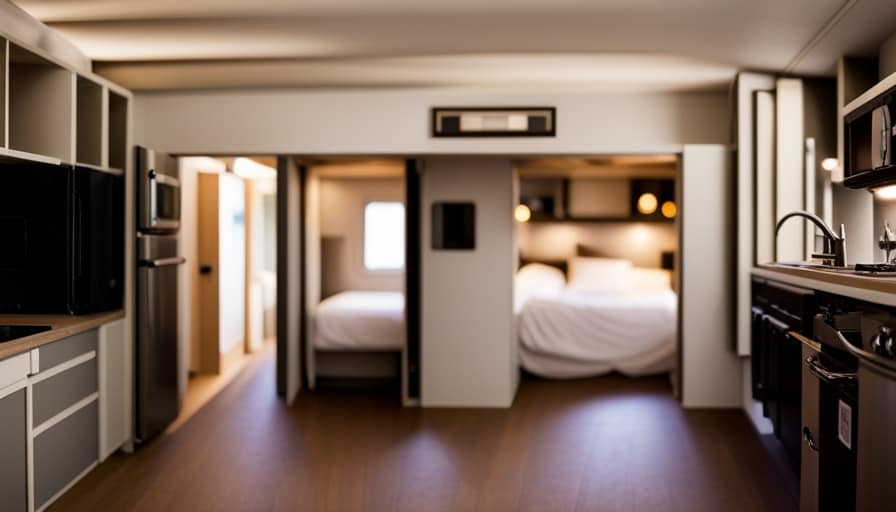
These natural remedies can be a safe and effective way to get rid of tiny bugs in your house.
Chemical Treatments for Eliminating Tiny Bugs
There are several effective chemical treatments available to eliminate tiny bugs in your house. When it comes to pest control methods, using insecticides is a common and efficient approach. There are various types of insecticides on the market, each with its own advantages and disadvantages.
It’s important to compare different insecticides to determine which one is best suited for your needs. Some insecticides target specific bugs, while others have a broad spectrum of effectiveness. Additionally, consider the application method and the duration of effectiveness. Some insecticides require direct contact with the bugs, while others can be used as a residual treatment.
It’s also essential to follow the safety instructions provided by the manufacturer when using chemical treatments to ensure the well-being of both humans and pets in your home.
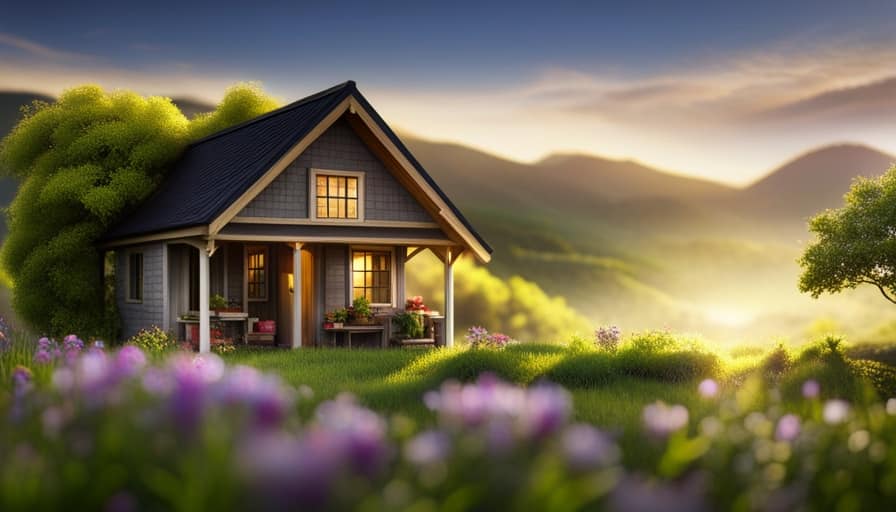
Preventing Future Bug Infestations in Your Home
I’ll make sure to regularly clean and seal any cracks in my house to keep bugs from coming in. Effective cleaning techniques are crucial in preventing bug infestations and creating a bug-free environment. Maintaining a clean and tidy home is essential to minimize the presence of bugs. Regularly vacuuming carpets and upholstery, sweeping and mopping floors, and wiping down surfaces will help eliminate any crumbs or food particles that may attract bugs. Additionally, proper food storage is essential to prevent bugs from being attracted to your kitchen. Keeping food in sealed containers and promptly cleaning up spills or crumbs will deter bugs from entering your home. Regularly inspecting and repairing any cracks or gaps in windows, doors, and walls will also help prevent bugs from finding their way inside.
| Cleaning Techniques | Maintenance Tips |
|---|---|
| Vacuum carpets and upholstery | Inspect and repair cracks or gaps |
| Sweep and mop floors | Properly store food to deter bugs |
| Wipe down surfaces | Regularly clean and seal cracks |
| Dispose of trash regularly | Keep a tidy and clutter-free home |
Frequently Asked Questions
Can These Tiny Bugs Cause Any Harm to Humans or Pets?
I’m not sure about the specific bugs in your house, but some tiny bugs can cause harm to humans or pets. It’s important to address the bug infestation promptly to protect your health and take preventive measures to keep them out.
How Long Does It Typically Take for Natural Remedies to Effectively Get Rid of Tiny Bugs?
It typically takes a few weeks for natural remedies to effectively eliminate tiny bugs. However, it’s important to note that results may vary. As for side effects, natural remedies are generally safe for humans and pets.
What Are Some Signs That Indicate a Bug Infestation in the House?
Signs of a bug infestation in the house include seeing live or dead bugs, finding their droppings or eggs, and noticing damage to furniture or walls. Preventing bug infestations involves keeping a clean and tidy home, sealing entry points, and using insect repellents.
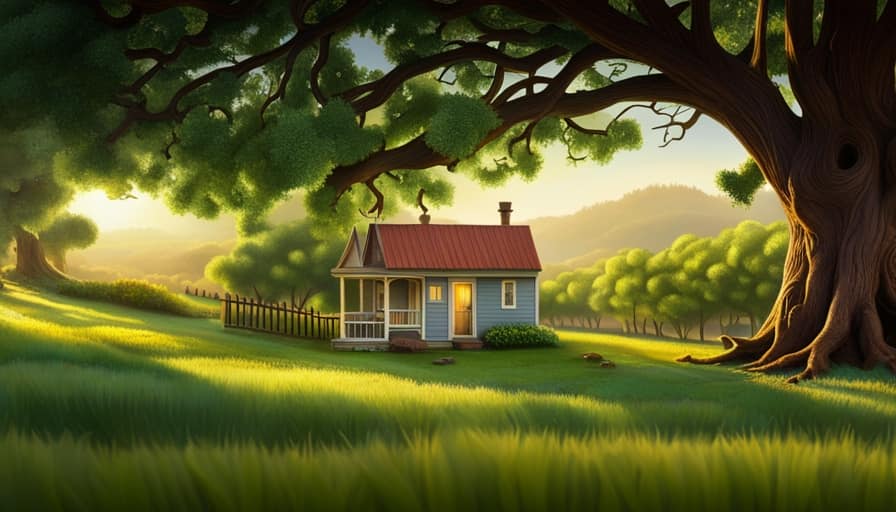
Are There Any Specific Areas in the House Where These Tiny Bugs Are Commonly Found?
In my experience, tiny bugs tend to hide in common areas like kitchen cabinets, bathrooms, and near windows. To prevent them, I recommend regular cleaning, sealing cracks, and keeping food stored properly.
Can Certain Weather Conditions or Changes in the Environment Attract These Tiny Bugs Into the House?
Certain weather conditions or changes in the environment can attract these tiny bugs into the house. Factors like warm and humid weather, open windows, and presence of organic matter can make your home more inviting for them.
Conclusion
In conclusion, while it can be frustrating to deal with tiny bugs in your house, there are effective ways to get rid of them.
By identifying the types of bugs and understanding the common causes of infestations, you can take natural or chemical treatments to eliminate them.

Additionally, taking preventive measures can help to avoid future bug infestations.
Remember, with the right knowledge and strategies, you can create a bug-free environment in your home.
I’m Theodore, and I love tiny houses. In fact, I’m the author of Tiny House 43, a book about tiny houses that are also tree houses. I think they’re magical places where imaginations can run wild and adventures are just waiting to happen.
While tree houses are often associated with childhood, they can be the perfect adult retreat. They offer a cozy space to relax and unwind, surrounded by nature. And since they’re typically built on stilts or raised platforms, they offer stunning views that traditional homes simply can’t match.
If you’re looking for a unique and romantic getaway, a tree house tiny house might just be the perfect option.
-

 Beginners Guides2 weeks ago
Beginners Guides2 weeks agoHow To Buy A Tesla Tiny House
-

 Energy Efficiency2 months ago
Energy Efficiency2 months agoBest Tiny Homes For Cold Climates
-

 Beginners Guides1 week ago
Beginners Guides1 week agoTiny House Nation Where Are They Now Stephanie
-

 Tiny House Resources (e.g., legalities, cost, insurance, FAQs)2 months ago
Tiny House Resources (e.g., legalities, cost, insurance, FAQs)2 months agoDo Tiny Homes Need Planning Permission?
-

 Beginners Guides3 weeks ago
Beginners Guides3 weeks agoFrom The Show Tiny House Nation How Many Keep Their Tiny House?
-

 Beginners Guides2 months ago
Beginners Guides2 months agoUsing a Climbing Net For Treehouse Construction
-

 Beginners Guides2 months ago
Beginners Guides2 months agoHow to Build a Treehouse Without Drilling Into the Tree
-

 Beginners Guides3 weeks ago
Beginners Guides3 weeks agoTiny House Nation Who Pays For The Houses




